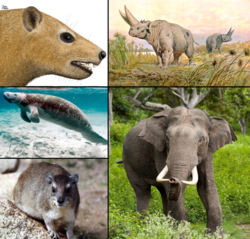Biology:Paenungulatomorpha
| Paenungulatomorpha | |
|---|---|

| |
| Crowned paenungulates and Ocepeia | |
| Scientific classification | |
| Domain: | Eukaryota |
| Kingdom: | Animalia |
| Phylum: | Chordata |
| Class: | Mammalia |
| Superorder: | Afrotheria |
| Clade: | Paenungulatomorpha Gheerbrant, 2016 |
| Subgroups | |
Paenungulatomorpha is a clade of afrotherian mammals that can be characterized according to Gheerbrant et al. (2016)[1]:
by a mandibular retromolar fossa, the absence of hypocone, an ectoloph selenodont and linked to strong styles such as mesostyle in basal taxa, and a more or less developed pseudohypocone.
Originally it was thought paenungulates were closely related to the perissodactyls in the clade Altungulata due to shared attributes in the dental, osteological and soft-tissues.[2][3][4] However this view was contested as molecular studies have widely supported that paenungulates are not related to the perissodactyls, instead more related to a widely different clade Afroinsectiphilia, with them forming the clade Afrotheria.[5][6][7][8][9] There has been also some morphological data to support Afrotheria,[10][11][12] though the paleontological record to support was lacking until reexamination of the genera Ocepeia[13] and Abdounodus,[1] as well as the description of the basal Hadrogeneios in 2023[14] has shown not only fossil evidence for the inclusion of paenungulates as afrotherians but also any morphological similarities between paenungulates and perissodactyls is due to convergence.[1]
Below is a cladogram from Gheerbrant (2023):[14]
| Paenungulatomorpha |
| ||||||||||||||||||||||||||||||||||||||||||
References
- ↑ 1.0 1.1 1.2 Emmanuel Gheerbrant; Andrea Filippo; Arnaud Schmitt (2016). "Convergence of Afrotherian and Laurasiatherian Ungulate-Like Mammals: First Morphological Evidence from the Paleocene of Morocco". PLOS ONE 11 (7): e0157556. doi:10.1371/journal.pone.0157556. PMID 27384169. Bibcode: 2016PLoSO..1157556G.
- ↑ Fischer, Martin S. (1986). "Die Stellung der Schliefer (Hyracoidea) im phylogenetischen System der Eutheria". Courier Forschungsinstitut Senckenberg 84: 1–132. ISBN 9783924500214. OCLC 15682192.
- ↑ Prothero, Donald R.; Schoch, Robert M. (1989). "Origin and Evolution of the Perissodactyla: Summary and Synthesis". in Prothero, Donald R.; Schoch, Robert M.. The Evolution of Perissodactyls. New York: Oxford University Press. pp. 504–37. ISBN 9780195060393. OCLC 19268080. http://www.donaldprothero.com/files/47440280.pdf. Retrieved 5 May 2013.
- ↑ Rose, Kenneth David (2006). The beginning of the age of mammals. Baltimore: JHU Press. ISBN 0801884721. https://books.google.com/books?id=3bs0D5ix4VAC.
- ↑ Stanhope, M. J.; Waddell, V. G.; Madsen, O.; de Jong, W.; Hedges, S. B.; Cleven, G. C.; Kao, D.; Springer, M. S. (1998). "Molecular evidence for multiple origins of Insectivora and for a new order of endemic African insectivore mammals". Proceedings of the National Academy of Sciences 95 (17): 9967–9972. doi:10.1073/pnas.95.17.9967. PMID 9707584. Bibcode: 1998PNAS...95.9967S.
- ↑ Springer, Mark S.; Michael J. Stanhope; Ole Madsen; Wilfried W. de Jong (2004). "Molecules consolidate the placental mammal tree". Trends in Ecology & Evolution 19 (8): 430–438. doi:10.1016/j.tree.2004.05.006. PMID 16701301. http://faculty.cns.uni.edu/~spradlin/evolution/Readings.blocked/mammaltrees.pdf.
- ↑ Robinson, T. J.; Fu, B.; Ferguson-Smith, M. A.; Yang, F. (2004). "Cross-species chromosome painting in the golden mole and elephant-shrew: support for the mammalian clades Afrotheria and Afroinsectiphillia but not Afroinsectivora". Proceedings of the Royal Society B: Biological Sciences 271 (1547): 1477–1484. doi:10.1098/rspb.2004.2754. PMID 15306319.
- ↑ Nishihara, H.; Satta, Y.; Nikaido, M.; Thewissen, J.G.M.; Stanhope, M.J.; Okada, N. (2005). "A retroposon analysis of Afrotherian phylogeny". Molecular Biology and Evolution 22 (9): 1823–1833. doi:10.1093/molbev/msi179. PMID 15930154.
- ↑ Tabuce, R.; Marivaux, L.; Adaci, M.; Bensalah, M.; Hartenberger, J.-L.; Mahboubi, M.; Mebrouk, F.; Tafforeau, P. et al. (2007). "Early Tertiary mammals from North Africa reinforce the molecular Afrotheria clade". Proceedings of the Royal Society B: Biological Sciences 274 (1614): 1159–1166. doi:10.1098/rspb.2006.0229. PMID 17329227.
- ↑ Seiffert, Erik R (2007). "A new estimate of afrotherian phylogeny based on simultaneous analysis of genomic, morphological, and fossil evidence". BMC Evolutionary Biology 7 (1): 224. doi:10.1186/1471-2148-7-224. PMID 17999766.
- ↑ Sánchez‐Villagra, Marcelo R.; Narita, Yuichi; Kuratani, Shigeru (2007). "Thoracolumbar vertebral number: The first skeletal synapomorphy for afrotherian mammals". Systematics and Biodiversity 5 (1): 1–7. doi:10.1017/S1477200006002258.
- ↑ Emmanuel Gheerbrant; Mbarek Amaghzaz; Baadi Bouya; Florent Goussard; Charlène Letenneur (2014). "Ocepeia (Middle Paleocene of Morocco): The Oldest Skull of an Afrotherian Mammal". PLOS ONE 9 (2): e89739. doi:10.1371/journal.pone.0089739. PMID 24587000. Bibcode: 2014PLoSO...989739G.
- ↑ 14.0 14.1 Gheerbrant, Emmanuel (2023-04-27). "Ancestral radiation of paenungulate mammals (Paenungulatomorpha)—new evidence from the Paleocene of Morocco" (in en). Journal of Vertebrate Paleontology 42 (5). doi:10.1080/02724634.2023.2197971. ISSN 0272-4634. https://www.tandfonline.com/doi/full/10.1080/02724634.2023.2197971.
Wikidata ☰ Q123509500 entry
This article needs additional or more specific categories. (November 2023) |
 |

